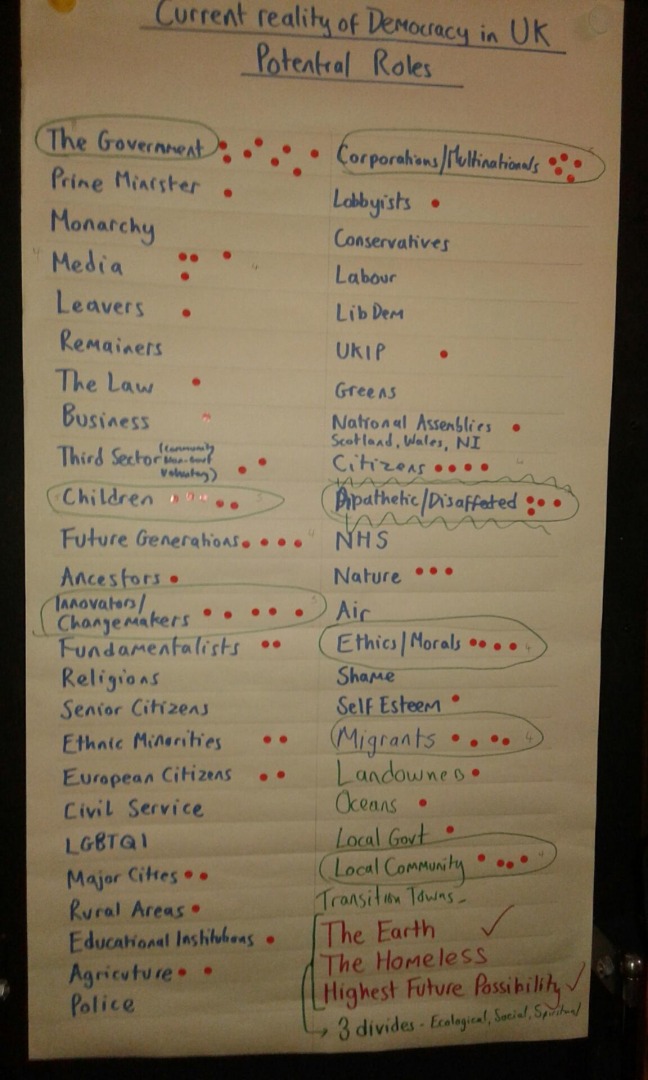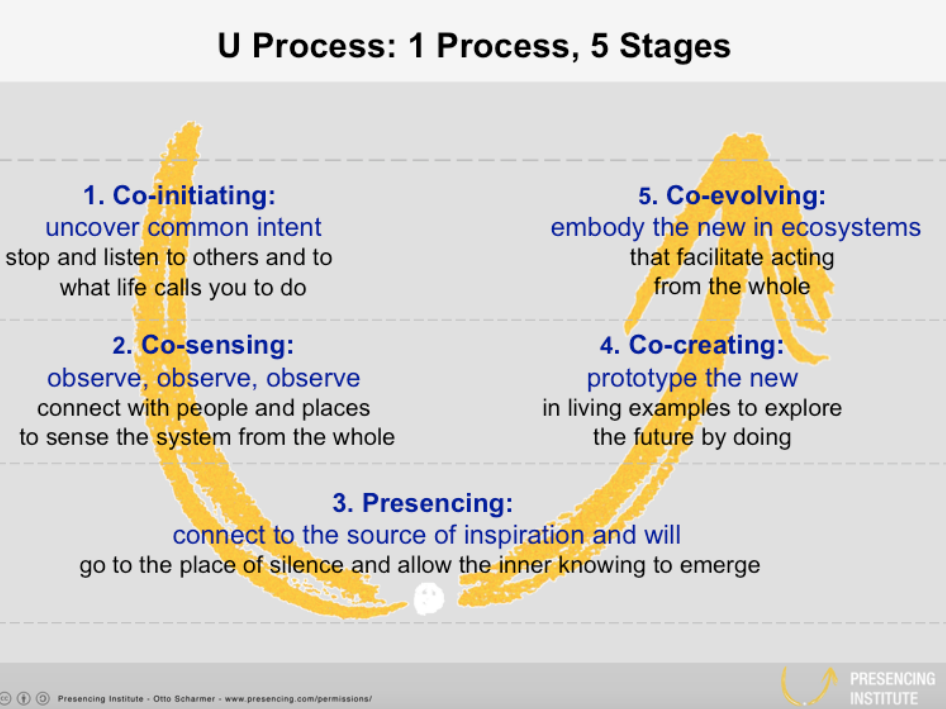Guest Post by Martha Cuffy
At a time in political history that has witnessed the UK exercising democratic rights with considerable consequences for future generations, it seemed appropriate that we chose to explore the state of democracy in the UK as part of the U.Lab course. One of the jewels in the crown of the MITx u.lab online course is 4D Mapping, a tool of the Social Presencing Theatre, designed to support the co-sensing process at the heart of Theory U founded by Otto Scharmer.
I was invited to facilitate this experience one day before the US elections with a group of 15 social innovators from the Impact Hub Kings Cross U.Lab group.
This was not an experience with the usual suspects or viewpoints. Using a process called Dotmocracy each person had four sticky dots to vote for the key roles needed to explore this topic. Ten roles were chosen, including 3 that represented some aspect of what Otto calls the Social Divide, the Spiritual Divide and the Ecological Divide. The remaining participants took the role of space holders, observers of what unfolded.

- The Earth
- Highest Future Possibility
- Ethics/Morals
- Government
- Corporations/Multi-nationals
- The Migrant
- Children
- The Homeless
- Local Community.
What was noticeable was the absence of political parties, any Brexit-flavoured role or any international institution, although the role of multi-nationals/corporations was selected.
Now comes the challenging part. Being able to embody the role without an agenda, a prior view of what one expects or want to happen is really challenging. How often do we have a ready-made counter argument in our back pocket before the other has even finished speaking? I sometimes noted how participants struggled with letting go of their mind and giving themselves time and physical space to feel into and experience their role. What unfolded was humbling, revealing and enduring as it continues to percolate in all the participants. (289)
The roles feel into a way to relate to each other to form Sculpture 1. This represents the current reality. What was noticeable was the isolation of Earth on the periphery. The Local Community was sat down, and said “I feel alienated and unrepresented”, with its back to Government who feels equally adrift as it says “I don’t see you”. The Migrant did not even speak, but let out a loud exhale in relief at making the shores of the UK. When The Homeless says “I need somewhere to belong” it shifts the emotional atmosphere in the room.
The shift into Sculpture 2 happens of its own accord and represents the movement from stillness from the bottom of the U into a new sense of Self, in this case the roles, that inspires a different form of action. It was as if the roles had woken up to what position and stance they had been holding and the impact this was having on the whole “social body”.

The Sculpture 2 that was created from this collective awareness showed more connection and through passages. This was reflected in the sharing from the different roles. Local Community: “could we find new ways to do what we’d like to do?” Corp: “I’m so sorry. Let’s make this work.” Homeless: “could I belong to community?”

This presents the participants with a radically different starting point from which to deepen and generate conversation. The emotion and insights that arose from this experience continue to percolate and influence the participants’ ongoing projects. It makes us aware of some of our comfortable assumptions that can lead to poor outcomes. The risk here is that left with a fixed view of the world, we cannot create a more engaged environment where all feel valued and heard. This co-sensing journey has given us a potent taste of what is possible if we slow down and really experience ourselves “our social body” in its current reality. (646)
Martha Cuffy is a Leadership Coach and facilitator who supports pioneering leaders to work with what is emerging in themselves, their teams and their environments. She is known for opening up untapped realms to reveal the deeper story to energise the spirit to make changes previously unimaginable. Learn more about her work – marthacuffy.com or Twitter: marthacuffy or Facebook MarthaJCuffy.

IntelligentHQ Your New Business Network.
IntelligentHQ is a Business network and an expert source for finance, capital markets and intelligence for thousands of global business professionals, startups, and companies.
We exist at the point of intersection between technology, social media, finance and innovation.
IntelligentHQ leverages innovation and scale of social digital technology, analytics, news and distribution to create an unparalleled, full digital medium and social business network spectrum.
IntelligentHQ is working hard, to become a trusted, and indispensable source of business news and analytics, within financial services and its associated supply chains and ecosystems.









